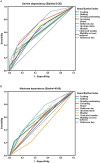Proposal for a revised Barthel index classification based on mortality risk assessment in functional dependence for basic activities of daily living
- PMID: 39877909
- PMCID: PMC11772177
- DOI: 10.3389/fpubh.2024.1478897
Proposal for a revised Barthel index classification based on mortality risk assessment in functional dependence for basic activities of daily living
Abstract
Introduction: Functional dependence on the performance of basic activities of daily living (ADLs) is associated with increased mortality. In this study, the Barthel index and its activities discriminate long-term mortality risk, and whether changes in this index are necessary to adapt it to detect mortality risk is examined.
Methods: Longitudinal study, carried out at the Orcasitas Health Center, Madrid (Spain), on the functional dependent population (Barthel ≤ 60). It included 127 people, with a mean age of 86 years (78.7% women and 21.3% men). Functional capacity was assessed using the Barthel index, and this index and each item it contains were analyzed as a test in relation to survival at three years, using tools that evaluate precision, discrimination, and calibration. The date of death was obtained from the health system.
Results: Greater dependency to perform chair-to-bed transfers was associated with an increased mortality risk (HR 2.957; CI 1.678-5.211). Also, individuals with severe (HR 0.492; CI 0.290-0.865) and moderate (HR 0.574; CI 0.355-0.927) ADL dependence had a reduced mortality risk when more independent in chair-to-bed transfers. Among people with moderate ADL dependence, this percentage was 48%. Using dependence-independence for chair-to-bed transfer as a screening test for mortality, the test showed high sensitivity (0.91) and specificity (0.83), a positive likelihood ratio of 5.45, and a negative likelihood ratio of 0.11. The area under the ROC curve was 0.814 (CI 0.658-0.970; p = 0.001), with a χ 2 = 0.235; p = 0.889, according to the Hosmer-Lemeshow test. The concordance C index was 0.814. According to Nagelkerke's R2, the model explained 53.1% of the variance in survival. As a screening test, "chair-to-bed transfer" was superior to the Barthel index.
Conclusion: ADL dependence for chair-to-bed transfers is an independent risk factor for mortality for any level of dependency. Therefore, a new classification of the Barthel index is proposed, in which "being dependent or requiring great assistance to perform chair-to-bed transfers" is considered severe dependence, even when the total score obtained via the Barthel Index is ≥40. We propose its use as a screening test in parallel to the Barthel index. The study suggests that the Barthel Index may have limitations in adequately discriminating mortality risk.
Keywords: Barthel index; basic activities of daily living; dependence; functional impairment; instrumental activities of daily living; mobility.
Copyright © 2025 Martín Moreno, Martínez Sanz, Martín Fernández, Guerra Maroto, Sevillano Fuentes, Pérez Rico, Sánchez González, Fernández Gallardo, Herranz Hernando, Benítez Calderón, Calderón Jiménez, Sánchez Rodríguez, Recuero Vázquez, Alonso Samperiz, León Saiz and Marcos Guerra.
Conflict of interest statement
The authors declare that the research was conducted in the absence of any commercial or financial relationships that could be construed as a potential conflict of interest.
Figures







Similar articles
-
The influence of nationwide COVID-19 lockdown on the functional impairment and long-term survival of dependent people for carrying out basic activities of daily living in a neighborhood of the city of Madrid, Spain: Orcasitas Cohort Longitudinal Study.Front Public Health. 2024 Jul 9;12:1385058. doi: 10.3389/fpubh.2024.1385058. eCollection 2024. Front Public Health. 2024. PMID: 39045161 Free PMC article.
-
Socio-health factors, ability to perform instrumental and basic activities of daily living, and use of assistive mobility devices during the COVID-19 pandemic: Interrelationships and impact on long-term survival.PLoS One. 2025 May 19;20(5):e0318481. doi: 10.1371/journal.pone.0318481. eCollection 2025. PLoS One. 2025. PMID: 40388524 Free PMC article.
-
The care of non-institutionalized ADL-dependent people in the Orcasitas neighborhood of Madrid (Spain) during the Covid-19 pandemic and its relationship with social inequalities, intergenerational dependency and survival.Front Public Health. 2024 Sep 25;12:1411390. doi: 10.3389/fpubh.2024.1411390. eCollection 2024. Front Public Health. 2024. PMID: 39386947 Free PMC article.
-
Longitudinal studies of dependence in daily life activities among elderly persons.Scand J Rehabil Med Suppl. 1996;34:1-35. Scand J Rehabil Med Suppl. 1996. PMID: 8701230 Review.
-
Muscle mass, strength, and physical performance predicting activities of daily living: a meta-analysis.J Cachexia Sarcopenia Muscle. 2020 Feb;11(1):3-25. doi: 10.1002/jcsm.12502. Epub 2019 Dec 1. J Cachexia Sarcopenia Muscle. 2020. PMID: 31788969 Free PMC article. Review.
Cited by
-
Effectiveness of sarcopenia screening indicators in predicting death in older patients with chronic heart failure.BMC Geriatr. 2025 Jun 4;25(1):406. doi: 10.1186/s12877-025-06069-3. BMC Geriatr. 2025. PMID: 40468203 Free PMC article.
-
Long-Term Benefits of N-Butylphthalide in Preventing Ischemic Stroke Recurrence: A 12-Month Prospective Study.Ther Clin Risk Manag. 2025 May 27;21:781-792. doi: 10.2147/TCRM.S521562. eCollection 2025. Ther Clin Risk Manag. 2025. PMID: 40453322 Free PMC article.
References
-
- Brugulat-Guiteras P, Puig-Oriol X, Mompart-Penina A, Séculi-Sánchez E, Salvà-Casanovas A. Dependencia para la realización de actividades de la vida diaria en las personas mayores de Cataluña [Dependency for activities of daily living in the elderly in Catalonia, Spain]. Med Clin (Barc). (2011) 137:32–6. doi: 10.1016/S0025-7753(11)70026-4, PMID: - DOI - PubMed
-
- Abizanda P, Romero L, Sánchez-Jurado PM, Martínez-Reig M, Alfonso-Silguero SA, Rodríguez-Mañas L. Age, frailty, disability, institutionalization, multimorbidity or comorbidity. Which are the main targets in older adults? J Nutr Health Aging. (2014) 18:622–7. doi: 10.1007/s12603-014-0033-3, PMID: - DOI - PubMed
MeSH terms
LinkOut - more resources
Full Text Sources
Research Materials

